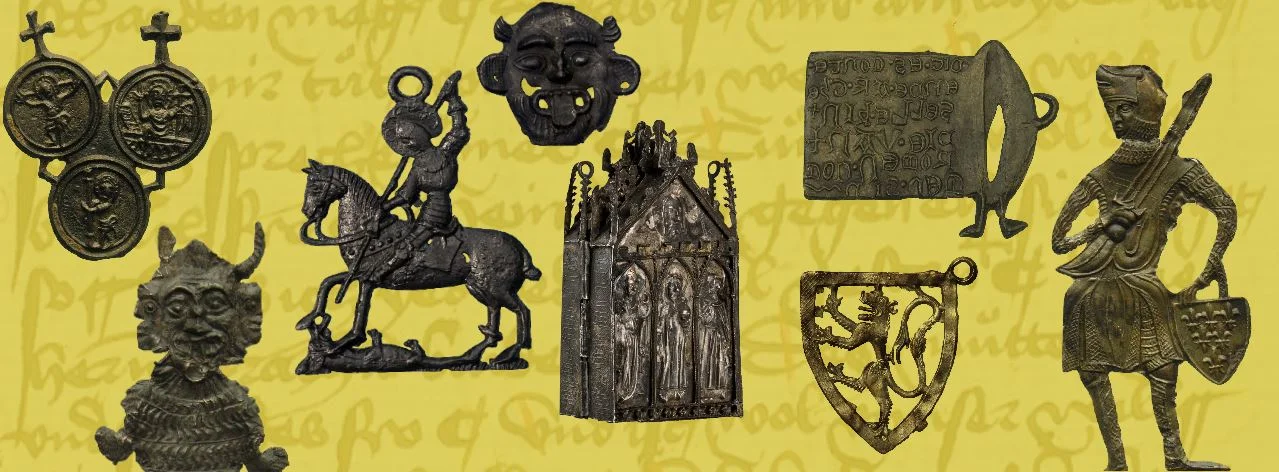Resources
GUIDE TO CURATING MEDIEVAL BADGES
The Guide to Curating Medieval Badges provides insight into the identification of badges (with helpful prompts and links for more information), and guidance on digitization, cataloguing and interpretation. A special thanks to Amy Jeffs for creating and sharing this guide, and for granting us permission to publish it here.
CAPTIONS TEMPLATE
The following templates follow Chicago Manual of Style note format.
For Badges
[Kind of object with material], [brief description], [place], [date], found in [place], [measurement, i.e. XX x XX mm]. [Location of institution holding object, name of institution holding object, inventory number] [if in HP then HP #] or [Kunera object #]. Photo: [name of permission holder].
Examples:
Pewter badge, holy communion wafers, Wilsnack, Brandenburg, Germany, 1475-1522, found in Nieuwlande, NL, 36 x 31 mm. The Van Beuningen Family Collection, inv. 1709 (Kunera 00130).
Pewter badge, king and bishop holding a tower encircled by decorative relief of stones alternating with male and female heads, origin unknown, found in Ypres, Belgium, 56 x 58 mm, 1325-1374. Ypres, Stedelijk Musea Ieper, 97.IVW.2.L3.F.1 (Kunera 06817). Photograph and permission from the Stedelijk Musea Ieper.
HELPFUL LINKS
The Kunera Database
On the Kunera Database, viewers can explore physical attributes of thousands of religious and profane badges and ampullae (including their attachment, material, and inscriptions), and geographical attributes (find site, origin). Click on the Union Jack for English language access.Medieval Badges Foundation
Publications from the Religious and Profane Medieval Badges Foundation, founded by collector H.J.E van Beuningen, and how to contact the organization can be found on the website. The website also features helpful information on badges, their documentation, collections, and exhibitions.Pilgerzeichen Datenbank (in German)
This database of pilgrim badges focuses on medieval badge finds from Central and Eastern Europe and is supported by various scholars in Germany.
The Digital Pilgrim Project
The Digital Pilgrim Project makes medieval badges more accessible by creating digital resources about them. A sample of 3D models of medieval badges is available through their website. Collected data about badges found in the United Kingdom and British badges found abroad will be presented as short films for the public online in the second phase of the project.Coats of Arms in Practice Project (in German)
The Coat of Arms in Practice Project focuses on the coat of arms and how it has made meaning in its socio-cultural and historical contexts. The academic blog, Heraldica Nova, which features discussion on heraldic sources, was created with the project.
FILM CLIP: CASTING A BADGE
In this video, Colin Torode of Lionheart Replicas casts a handmade replica of a pilgrim souvenir showing Saint Thomas Becket inside a capital 'T' (one of many designs sold to Canterbury pilgrims). Witnessing the casting process illustrates the speed and efficiency badges could be made with and how they would have sparkled on stalls when new, attracting the custom of all kinds of pilgrims.
This film clip was made by the Digital Pilgrim Project (supported by the Paul Mellon Centre for Studies in British Art).
INTERACTIVE 3D MODELS
There are thousands of medieval badges in museum collections, but few people have the opportunity to see them up close. Detailed digital reproductions can be made with newly accessible technologies like digital 3D modeling and uploaded to free viewing platforms like Sketchfab.
The Digital Pilgrim Project (supported by the Paul Mellon Centre for Studies in British Art) has made 3D models of twelve medieval pilgrim souvenirs and secular badges in the 680-strong collection at the British Museum, much of which was excavated from the River Thames. Interactive annotations help tell the badges' stories and the high quality of the scans allows the viewer to see every detail.
Banner image badge photographs are courtesy of the Family Van Beuningen Collection. Script courtesy of the Universitätbibliothek Heidelberg.
